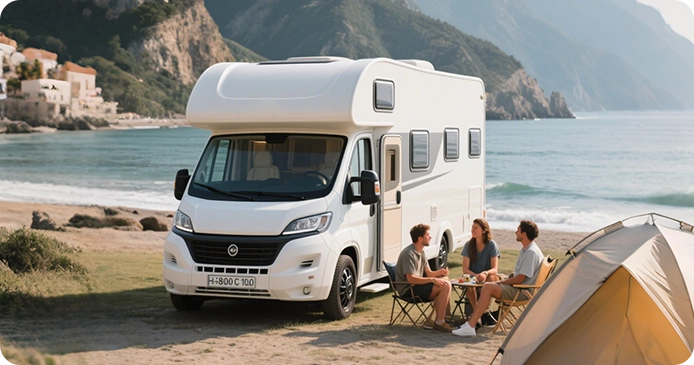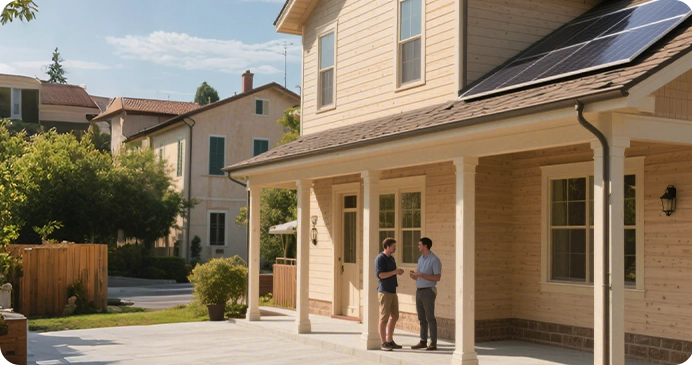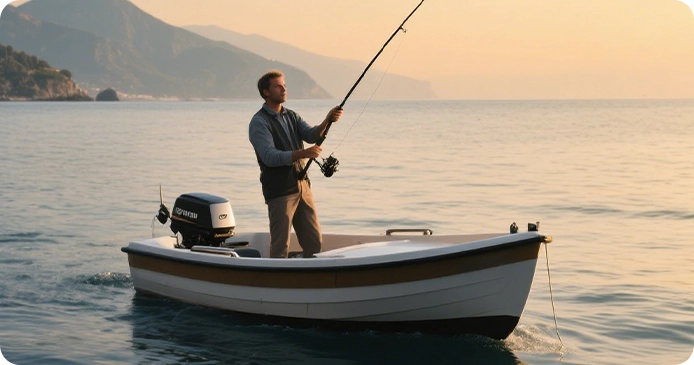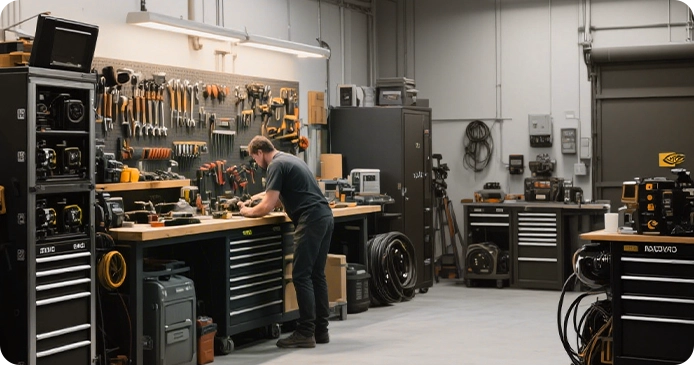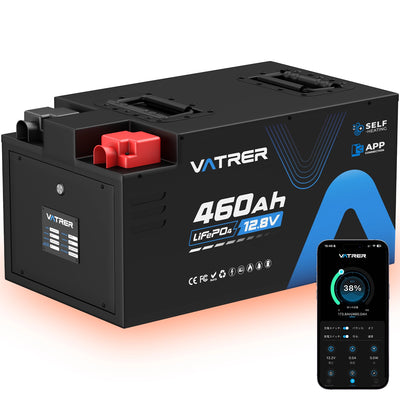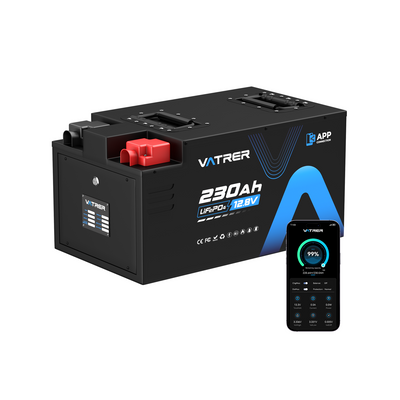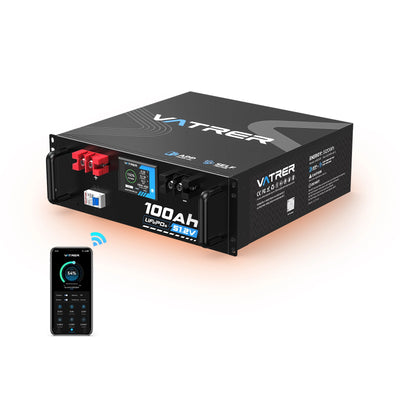RVに必要なディープサイクルバッテリーのサイズは?
Reading time 1 minutes
RV用のディープサイクルバッテリーのサイズを適切に選ぶことで、キャンプ体験全体をより充実したものにすることができます。週末旅行で冷蔵庫に電力を供給する場合でも、オフグリッドで複数の家電製品に電力を供給する場合でも、適切なバッテリーサイズを選ぶことで、RVに安定した電力を供給できます。この記事では、必要な電力の計算からキャンプのニーズに合ったバッテリーの種類の比較まで、明確で実用的なアドバイスを提供します。

RV キャンプ用のディープサイクルバッテリーとは何ですか?
ディープサイクル バッテリーは、エンジンを始動するために短時間のバースト電力を供給する始動用バッテリーとは異なり、長期間にわたって安定した電力を供給します。
これらのバッテリーは、損傷することなく 80% まで、またはリチウムの場合は 90 ~ 100% まで放電できるため、ライト、ウォーターポンプ、冷蔵庫などに電力を供給するRV ディープ サイクル バッテリーに最適です。
リン酸鉄リチウム(LiFePO4)バッテリーは、その効率性、長寿命、そして軽量設計(鉛蓄電池よりも50%軽量な場合が多く、RVの燃費向上に貢献)により、RVキャンプに最適です。キャンプ場でも、辺鄙な場所でのブーンドッキングでも、これらのバッテリーは冒険に必要な信頼できる電力を供給します。
RV にディープサイクル バッテリーを選ぶ理由
RV用ディープサイクルバッテリーは、陸上電源が利用できないときに電気系統に電力を供給するために不可欠です。RVキャンプにディープサイクルバッテリーが必須な理由は次のとおりです。
- 安定した電力供給:照明、扇風機、家電製品などの必需品に安定した電力を供給します。例えば、週末キャンプをする人は冷蔵庫に電力を供給し、フルタイムのRVユーザーはエアコンやノートパソコンを稼働させることができます。
- 長寿命: リチウム電池は、適切な取り扱いをすれば 4,000 ~ 5,000 回の充電サイクルで 8 ~ 10 年持続します。一方、鉛蓄電池は 3 ~ 5 年持続するため、長期的な交換コストが削減されます。
- オフグリッドの信頼性: ブーンドッキングでは、ディープサイクル バッテリーが信頼性の高い電力を提供し、安心して遠隔地でのキャンプを可能にします。
- 複数デバイスのサポート: 同時負荷を処理できるため、バッテリーを急速に消耗させることなく、テレビを稼働させ、携帯電話を充電し、ウォーターポンプに電力を供給することができます。
- エネルギー効率:リチウム電池は非常に効率が高く、充電頻度を最小限に抑え、太陽光発電システムや発電機システムとの相性も抜群です。また、リサイクル可能な素材を使用しているため、従来の電池に比べて廃棄物を削減でき、環境に優しい選択肢となります。
適切なRV バッテリー サイズを選択すると、短期旅行の場合でも、常時オフグリッド生活を送る場合でも、RV の電気需要が満たされます。

RVのディープサイクルバッテリーの必要量を計算する方法
RV用ディープサイクルバッテリーの適切なサイズを選ぶには、RVの1日の消費電力を計算する必要があります。これにより、バッテリーが切れることなく家電製品に電力を供給できるようになります。以下の手順に従ってください。
- 家電製品をリストアップする: 冷蔵庫、LED ライト、テレビなど、使用するすべての機器を特定します。
- ワット数を確認する: 各電化製品の消費電力をワット単位で調べるには、ラベルまたはマニュアルを確認してください。
- 使用時間の見積もり: 各アプライアンスが毎日何時間実行されるかを記録します。
- エネルギー使用量の計算: ワット数と時間を掛けて機器ごとのワット時間 (Wh) を算出し、合計して 1 日あたりの合計使用量を算出します。
- 安全マージンの追加: 非効率性や予期しない負荷を考慮して、10 ~ 20% の追加容量を含めます。
たとえば、次の場合を考えてみましょう。
- 冷蔵庫(150W、8時間=1200Wh)
- LEDライト5個(各10W、5時間=250Wh)
- テレビ(50W、3時間 = 150Wh)
1日あたりの合計使用量:1200 + 250 + 150 = 1600Wh。20%の余裕分を加えると1920Whになります。12V 200Ahリチウムバッテリー(約2560Wh、放電制限により2000~2200Wh使用可能)なら、このニーズを満たすことができます。
次の表は、一般的な RV 機器のエネルギー消費量を示しており、RV 固有の電力ニーズを満たすバッテリーを推定して選択するのに役立ちます。
| 家電製品 | 電力(ワット) | 1日の使用時間(時間) | 1日のエネルギー(Wh) |
|---|---|---|---|
| 冷蔵庫 | 150 | 8 | 1200 |
| LED照明 | 10/ライト | 5 | 50 |
| 携帯電話充電器 | 5 | 4 | 20 |
| 電子レンジ | 1000 | 0.5 | 500 |
| テレビ | 50 | 3 | 150 |
一般的なRV用ディープサイクルバッテリーのサイズの選択
適切なバッテリー サイズを選択するには、容量 (アンペア時間、Ah)、電圧、および物理的寸法を RV の電気システムとコンパートメント スペースに一致させる必要があります。
一般的なRV ディープサイクル バッテリーのサイズには、 12Vシステム用のグループ 24、グループ 27、グループ 31 があり、大型 RV 用の24Vおよび48Vオプションがあります。
RVのバッテリーコンパートメントのサイズを測り、適切なサイズであることを確認してください。以下の表は、一般的なRVバッテリーのサイズをまとめたものです。ご参考の上、お選びください。
| バッテリーサイズ | 寸法(長さ×幅×高さ、インチ) | 電圧 | 容量(Ah) | エネルギー(Wh) | 最適な用途 |
|---|---|---|---|---|---|
| グループ24 | 10.24 × 6.61 × 8.23 | 12V | 100 | 1280 | 小型RV、ポップアップキャンピングカー、週末旅行 |
| グループ31 | 12.95 × 6.77 × 8.42 | 12V | 100 | 1280 | 中型RV、短距離旅行 |
| 12V 200Ah | 20.55 × 9.44 × 8.58 | 12V | 200 | 2560 | 大型RV、中程度の家電使用 |
| 12V 300Ah | 15.16 × 7.56 × 9.76 | 12V | 300 | 3840 | 大型キャンピングカー、オフグリッド利用の拡大 |
| 12V 460Ah | 18.78 × 10.75 × 9.92 | 12V | 460 | 5888 | 中型/大型RV、頻繁に使用 |
| 12V 560Ah | 16.69 × 14.80 × 11.14 | 12V | 560 | 7168 | クラスA/フィフスホイールRV、フルタイムRV |
RVタイプの場合:
- クラス B (キャンピングカー) : ライトやファンなどの基本的な電化製品用の 12V 100Ah。
- クラス C モーターホーム: 中程度の用途 (冷蔵庫、テレビ) の場合、12V 100-200Ah または 24V 200Ah。
- クラス A モーターホーム: 需要の高い電化製品を備えたフルタイム RV 用 12V/24V 100-460Ah。
- 旅行用トレーラー(小型) :週末のキャンプに最適な 12V 100-200Ah。
- 旅行用トレーラー (大型) : 複数の電化製品を搭載した長期旅行に適した 24V 200Ah。
- フィフスホイール/トイハウラー:高需要システム(工具、エアコン)用の 12V/24V 200-560Ah。
- ポップアップ キャンパー: 照明などの最小限のニーズに対応する 12V 100Ah。
最適なサイズの24インチディープサイクルRVバッテリー(12V 100Ah)は、コンパクトなサイズと十分な容量のため、小型RVに人気です。大型のRVには、より大容量のバッテリーが必要です。必ずRVの電圧とコンパートメントのサイズをご確認ください。
また、Vatrer のオンライン計算機を使用して、正確なバッテリー ソリューションを得ることもできます。
RV用ディープサイクルバッテリーの一般的な種類を比較
RVに最適なバッテリーの種類は、予算、走行頻度、そして電力ニーズによって異なります。RVで一般的に使用されているディープサイクルバッテリーの比較表をご紹介します。ご自身の使用頻度に最適なバッテリーをしっかりと理解し、お選びいただくためにお役立てください。
液浸型鉛蓄電池
- 利点: 手頃な価格で、広く入手可能。
- 短所: メンテナンスが必要(水位の確認)、こぼれやすい、寿命が短い(2~3年)、極端な温度では効率が悪い。
- 最適な用途: 時々キャンプをしたり、予算を抑えたセットアップ。
AGMバッテリー
- 利点: メンテナンスフリー、液漏れなし、充電が速い、液式鉛蓄電池よりも耐久性が高い。
- 短所: リチウムよりも重い、寿命が短い (5 〜 7 年)、コストが中程度。
- 最適な用途: 短い旅行、中程度の予算。
ゲル電池
- 利点: メンテナンスフリー、耐振動性、こぼれ防止。
- 短所:過充電に敏感、コストが高い、リチウムよりも寿命が短い。
- 最適な用途: オフロード RV、中程度の予算。
リチウム(LiFePO4)電池
- メリット:軽量(鉛蓄電池より50%軽量)、長寿命(適切なメンテナンスで8~10年、4,000~5,000サイクル)、急速充電、安定した電圧、-4°F~140°Fの温度範囲で優れた性能、環境に優しい(リサイクル可能)。内蔵のバッテリーマネジメントシステム(BMS)が、過充電、過放電、ショート、極端な温度からバッテリーを保護します。
- 短所: 初期費用が高く、リチウム対応の充電器が必要です。
- 最適な用途: 頻繁な旅行、オフグリッドキャンプ、長期投資。
リチウムバッテリーは、鉛蓄電池やAGMバッテリーの50%放電に対し、90~100%まで損傷なく放電できるため、RVでの使用に最適です。初期費用は高くなりますが、10年間の寿命により、3~5年ごとに鉛蓄電池を交換する場合と比べて500~1,000ドルの節約が可能です。また、リサイクル可能な素材を使用しているため、環境への影響も軽減され、持続可能な選択肢となります。

RVディープサイクルバッテリーの安全性と取り付けのヒント
RVディープサイクルバッテリーを正しく取り付けることで、安全性と性能を確保できます。以下の手順に従ってください。
- 安全な取り付け: 移動中にバッテリーが動かないように、ブラケットまたはストラップでバッテリーを固定します (メーカーの仕様に従ってボルトを 5 ~ 8 Nm にトルク調整します)。
- 換気: 鉛蓄電池はガスを放出するため、十分な空気の流れが必要ですが、リチウム電池は最小限の換気しか必要としないため、狭い空間でも安全に使用できます。
- 電圧の互換性>: RV の電気システム (12V、24V、または 48V) がバッテリーと一致していることを確認します。
- 配線: 短絡を避けるため、接続については製造元のガイドラインに従ってください。
- リチウムの安全性: LiFePO4 バッテリーには、過充電、過放電、過熱から保護する BMS が含まれており、RV の安全な使用を保証します。
- 廃棄:環境への影響を最小限に抑えるため、リチウム電池は認定センターでリサイクルしてください。
安全を確保するために、RV のマニュアルを参照するか、複雑な設置については専門家に相談してください。
RV用リチウムディープサイクルバッテリーの充電方法
リチウム RV ディープサイクル バッテリーは、パフォーマンスを最適化するために特別な充電システムを必要とします。
- ソーラー充電:LiFePO4バッテリーはAGMバッテリーの2~3倍の速さで充電でき、ソーラーパネルとの併用に最適です。リチウム対応のソーラー充電コントローラーをご使用ください。
- オルタネーターの充電: RV のオルタネーターからの電圧を調整するために DC-DC 充電器を設置します。
- コンバーター充電: 損傷を防ぐために、陸上電源充電にはリチウム対応コンバーターを使用してください。
- 温度に関する注意事項:自己発熱型リチウムバッテリーを使用しない限り、0℃以下での充電は避けてください。リチウムバッテリーは-4℃~140℃の温度範囲で正常に動作します。Vatrer 12V RVバッテリーは自己発熱機能を備えており、電力供給を維持します。
- モニタリング:Bluetoothアプリで充電状況をリアルタイムに追跡し、電力管理を簡素化します。VatrerバッテリーはBMSとBluetooth機能を搭載しており、電力使用を合理的に計画できます。
これらのオプションにより充電時間が短縮され、オフグリッドの信頼性が向上するため、リチウムは RV キャンプに最適です。

RVアドベンチャーに最適なディープサイクルバッテリーの選び方
RV用ディープサイクルバッテリーの適切なサイズ選びは、RVの種類、電力ニーズ、そしてキャンプスタイルによって異なります。小型RVやポップアップキャンピングカーでの週末旅行には、 12V 100Ahのリチウムバッテリーで基本的な電化製品に十分な電力を供給できます。
クラス A のモーターホームやフィフスホイール トレーラーなどの大型 RV では、エアコンやツールなどの需要の高い電化製品向けに、100 ~ 560Ah の12Vまたは24Vシステムが役立ちます。
Vatrer は、安全のための内蔵 BMS と自己発熱、リアルタイムの充電追跡のための Bluetooth モニタリング、ほとんどの RV コンパートメントに適合するコンパクトな設計など、高度な機能を備えた信頼性の高いRV LiFePO4 バッテリーを提供しています。
最適なRVバッテリーサイズを選ぶには、上記の手順に従ってエネルギー需要を計算し、RVの仕様を確認し、Vatrerのテクニカルサポートにご相談ください。詳細な仕様を確認して、次の冒険に備えましょう!
最適な RV サイズに関する情報が得られたので、最終的な購入決定を下す際に役立つ次の情報もお読みください。
よくある質問
RV バッテリーはディープサイクルですか?
ほとんどのRVバッテリーはディープサイクルバッテリーで、照明、冷蔵庫、ウォーターポンプなどの家電製品に長時間安定した電力を供給するように設計されています。RVエンジンを始動させるために使用される始動用バッテリーとは異なり、RVディープサイクルバッテリーは、繰り返し放電(リチウムの場合は最大80~100%)しても損傷しないように設計されています。ただし、一部のRVでは始動用とディープサイクル用の兼用バッテリーを使用している場合がありますので、バッテリーの仕様をご確認ください。
ディープサイクル RV バッテリーの寿命はどのくらいですか?
ディープサイクルRVバッテリーの寿命は、バッテリーの種類と使用状況によって異なります。リチウム(LiFePO4)バッテリーは、高温や過放電を避けるなど適切なメンテナンスを行えば、通常8~10年、または4,000~5,000回の充電サイクルで使用できます。AGMバッテリーは5~7年(500~1,000サイクル)、鉛蓄電池は2~3年(200~400サイクル)使用できます。バッテリーの寿命を最大限に延ばすには、涼しく乾燥した場所に保管し、メーカーの充電ガイドラインに従ってください。
ディープサイクル RV バッテリーを充電するにはどうすればいいですか?
RV用ディープサイクルバッテリーの充電には、バッテリーの種類に適した方法が必要です。リチウムバッテリーの場合は、マルチステージ充電器を使用し、12Vバッテリーのバルク電圧(14.4~14.6V)とフロート電圧(13.5~13.8V)を調整することで、安全かつ効率的な充電を実現できます。
鉛蓄電池用に設計されたトリクル充電器は、リチウムセルを損傷する可能性があるため、使用を避けてください。AGMバッテリーまたは鉛蓄電池の場合は、それぞれのバッテリーの化学組成に合わせた設定の充電器を使用してください(通常、AGMバッテリーは14.7V、液式鉛蓄電池は14.4V)。鉛蓄電池の充電は、ガス排出を抑えるため、必ず換気の良い場所で行ってください。また、過充電を防ぐため、充電レベルを監視してください。
最高のディープサイクル RV バッテリーを製造しているのは誰ですか?
最適なディープサイクルRVバッテリーのサイズはニーズによって異なりますが、 Vatrer BatteryのようなブランドはLiFePO4バッテリーで高い評価を得ています。Vatrerは、安全性を高める堅牢なバッテリー管理システム(BMS)、寒冷地充電を可能にする自己発熱機能、リアルタイムのパフォーマンストラッキングを可能にするBluetoothモニタリングなどの機能を備えており、頻繁に利用されるRVキャンプやオフグリッドキャンプに最適です。
私の RV がリチウム バッテリーをサポートしているかどうかはどうすればわかりますか?
RV用リチウムディープサイクルバッテリーを使用するには、RVの電気系統がバッテリーの電圧(通常は12V 、 24V 、または48V )に対応していること、および充電器またはコンバーターがリチウムバッテリーに対応していることを確認してください。古いRVの中には、過充電を防ぐために充電器のアップグレードが必要になるものもあります。互換性や必要な改造については、RVのマニュアルを参照するか、専門の技術者にご相談ください。
シェア


























